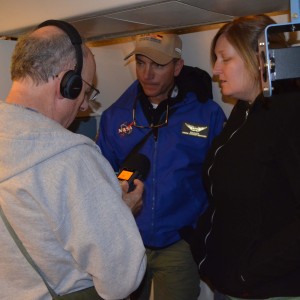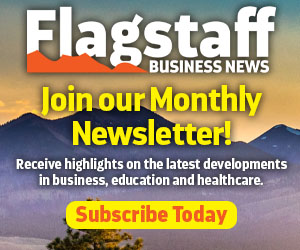 Two Flagstaff educators recently took to new heights in their quest to share their excitement of space. Cruising aboard a NASA flying observatory in September, Samantha Thompson and Rich Krueger saw firsthand the complexity of a telescope operating from an elevation of 43,000 feet. They plan to incorporate what they learned into new STEM-themed exhibits that will be displayed around Northern Arizona.
Two Flagstaff educators recently took to new heights in their quest to share their excitement of space. Cruising aboard a NASA flying observatory in September, Samantha Thompson and Rich Krueger saw firsthand the complexity of a telescope operating from an elevation of 43,000 feet. They plan to incorporate what they learned into new STEM-themed exhibits that will be displayed around Northern Arizona.
Thompson and Krueger flew on SOFIA (Stratospheric Observatory for Infrared Astronomy) as part of NASA’s Airborne Astronomy Ambassador program. The goal of this effort is to increase scientific literacy. Each year, a new group of educator teams are chosen to help fulfil this mission.
“There are two components to the applications,” said Dana Backman, SOFIA outreach manager. “The educators have to talk about how they are going to improve the science and STEM education within their institutions, plus they have to have a public engagement plan, a way to somehow leverage their experience into the local neighborhood.”
For Thompson, curator at Lowell Observatory, and Krueger, a teacher at the Flagstaff Arts and Leadership Academy, they plan to build an exhibit that centers around a replica of the interior of SOFIA, a modified 747SP plane retrofitted with a 100-inch telescope. It flies at altitudes between 39,000 and 45,000 feet, collecting data from the infrared portion of the electromagnetic spectrum. “I understand that not everyone can fly on SOFIA, but that doesn’t mean they shouldn’t be able to experience the excitement of airborne observing,” said Thompson.
The replica will include a full-scale mock-up of the main cabin, with stations for each of the main areas of operations (science, telescope operations, mission control, and education) where visitors can listen-in, through the same head-sets worn during flight, to the scientists, engineers and pilots at work aboard SOFIA.
“In order to successfully tell the story of this research program, it was critical to have first-hand experience riding alongside and watching the scientists and engineers at work during a flight,” said Thompson.
The two educations have the ability to reach broad audiences, with Thompson focused on informal science settings such as Lowell Observatory and Krueger on his school and other schools in the area.
Together the team also will reach the community through the Flagstaff Festival of Science and Flagstaff’s annual STEM Night.
“Through Rich’s exceptional teaching record, I am confident we will make a big impact in the local schools, especially with his students,” said Thompson. “It will also give these students a chance to connect, and work alongside, real working astronomers at a prestigious, local observatory,” said Thompson.
Krueger teaches primarily high school science classes. “I teach from the phenomena basis, where I give the kids a phenomenon and ask them ‘How do we understand that?’ Flying on SOFIA and participating in a research project gives me the tools to do so,” he said.
Krueger also is an avid amateur astronomer, a passion that he shares with his students. FBN
Written by Kevin Schindler







